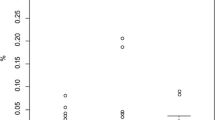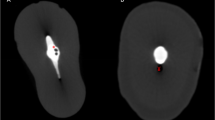Abstract
Objectives
The aim of this study was to compare two different thermoplastic techniques—a core-carrier technique (Thermafil) and warm vertical compaction—in terms of overextension of root canal filling in vivo.
Materials and methods
Flaring of 88 teeth was conducted using Pro Files .04 as finishing files, and the teeth were obturated using Thermafil. Flaring of 74 teeth was performed using Pro Files .06 as finishing files, and the teeth were obturated using warm vertical compaction.
Results
Seventy (80 %) of the teeth obturated using Thermafil and 31 (42 %) teeth obturated using warm vertical compaction show extruded root canal filling. In contrast to Thermafil, there is a higher rate of extruded root canal filling of teeth with more than one root canal using warm vertical compaction.
Conclusion
Thermafil demonstrated a higher rate of extruded root canal filling compared to warm vertical compaction. Warm vertical compaction is a more predictable method of filling compared to Thermafil.
Clinical relevance
Root canal filling extrusion will cause irritation of the surrounding tissue and impair repair processes. In the present in vivo study, there was a higher rate of root canal filling extrusion using Thermafil compared to warm vertical compaction.

Similar content being viewed by others
References
Hulsmann M, Peters OA, Dummer PMH (2005) Mechanical preparation of root canals: shaping goals, techniques and means. Endod Top 10:30–76
Peng L, Ye L, Tan H, Zhou X (2007) Outcome of root canal obturation by warm gutta-percha versus cold lateral condensation: a meta-analysis. J Endod 33:106–109
Michanowicz AE, Michanowicz JP, Michanowicz AM, Czonstkowsky M, Zullo TP (1989) Clinical evaluation of low-temperature thermoplasticized injectable gutta-percha: a preliminary report. J Endod 15:602–607
Leduc J, Fishelberg G (2003) Endodontic obturation: a review. Gen Dent 51:232–233
Wu MK, Fan B, Wesselink PR (2000) Diminished leakage along root canals filled with gutta-percha without sealer over time: a laboratory study. Int Endod J 33:121–125
Gilhooly RM, Hayes SJ, Bryant ST, Dummer PM (2000) Comparison of cold lateral condensation and a warm multiphase gutta-percha technique for obturating curved root canals. Int Endod J 33:415–420
Gilhooly RM, Hayes SJ, Bryant ST, Dummer PM (2001) Comparison of lateral condensation and thermomechanically compacted warm alpha-phase gutta-percha with a single cone for obturating curved root canals. Oral Surg Oral Med Oral Pathol Oral Radiol Endod 91:89–94
Schafer E, Olthoff G (2002) Effect of three different sealers on the sealing ability of both thermafil obturators and cold laterally compacted gutta-percha. J Endod 28:638–642
Silver GK, Love RM, Purton DG (1999) Comparison of two vertical condensation obturation techniques: touch ‘n heat modified and system b. Int Endod J 32:287–295
Johnson WB (1978) A new gutta-percha technique. J Endod 4:184–188
Gencoglu N, Orucoglu H, Helvacioglu D (2007) Apical leakage of different gutta-percha techniques: thermafil, js quick-fill, soft core, microseal, system b and lateral condensation with a computerized fluid filtration meter. Eur J Dent 1:97–103
Schilder H (1967) Filling root canals in three dimensions. Dent Clin North Am 723–44
Venturi M, Breschi L (2004) Evaluation of apical filling after warm vertical gutta-percha compaction using different procedures. J Endod 30:436–440
Gencoglu N, Garip Y, Bas M, Samani S (2002) Comparison of different gutta-percha root filling techniques: thermafil, quick-fill, system b, and lateral condensation. Oral Surg Oral Med Oral Pathol Oral Radiol Endod 93:333–336
Clinton K, Van Himel T (2001) Comparison of a warm gutta-percha obturation technique and lateral condensation. J Endod 27:692–695
Da Silva D, Endal U, Reynaud A, Portenier I, Orstavik D, Haapasalo M (2002) A comparative study of lateral condensation, heat-softened gutta-percha, and a modified master cone heat-softened backfilling technique. Int Endod J 35:1005–1011
Kececi AD, Unal GC, Sen BH (2005) Comparison of cold lateral compaction and continuous wave of obturation techniques following manual or rotary instrumentation. Int Endod J 38:381–388
Robinson MJ, McDonald NJ, Mullally PJ (2004) Apical extrusion of thermoplasticized obturating material in canals instrumented with Profile 0.06 or Profile GT. J Endod 30:418–421
Schaeffer MA, White RR, Walton RE (2005) Determining the optimal obturation length: a meta-analysis of literature. J Endod 31:271–274
Kojima K, Inamoto K, Nagamatsu K, Hara A, Nakata K, Morita I, Nakagaki H, Nakamura H (2004) Success rate of endodontic treatment of teeth with vital and nonvital pulps. A meta-analysis. Oral Surg Oral Med Oral Pathol Oral Radiol Endod 97:95–99
Vieyra JP, Acosta J (2011) Comparison of working length determination with radiographs and four electronic apex locators. Int Endod J 44:510–518
Ruddle CJ (2010) Filling root canal systems: the Calamus 3-D obturation technique. Dent Today 29(76):78–81
Wu MK, van der Sluis LW, Wesselink PR (2002) A preliminary study of the percentage of gutta-percha-filled area in the apical canal filled with vertically compacted warm gutta-percha. Int Endod J 35:527–535
Sari S, Duruturk L (2007) Radiographic evaluation of periapical healing of permanent teeth with periapical lesions after extrusion of AH plus sealer. Oral Surg Oral Med Oral Pathol Oral Radiol Endod 104:e54–e59
Guess GM, Edwards KR, Yang ML, Iqbal MK, Kim S (2003) Analysis of continuous-wave obturation using a single-cone and hybrid technique. J Endod 29:509–512
Liang YH, Li G, Wesselink PR, Wu MK (2011) Endodontic outcome predictors identified with periapical radiographs and cone-beam computed tomography scans. J Endod 37:326–331
Sjogren U, Hagglund B, Sundqvist G, Wing K (1990) Factors affecting the long-term results of endodontic treatment. J Endod 16:498–504
Bergenholtz G, Lekholm U, Milthon R, Engstrom B (1979) Influence of apical overinstrumentation and overfilling on re-treated root canals. J Endod 5:310–314
Conflict of interest
The authors deny any conflicts of interest related to this study.
Author information
Authors and Affiliations
Corresponding author
Rights and permissions
About this article
Cite this article
Tennert, C., Jungbäck, I.L. & Wrbas, KT. Comparison between two thermoplastic root canal obturation techniques regarding extrusion of root canal filling—a retrospective in vivo study. Clin Oral Invest 17, 449–454 (2013). https://doi.org/10.1007/s00784-012-0726-0
Received:
Accepted:
Published:
Issue Date:
DOI: https://doi.org/10.1007/s00784-012-0726-0




